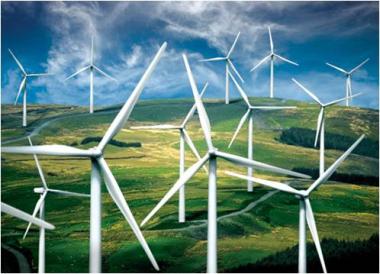No Kind of Hula Hoop:
How GE Turned Wind Energy into Billion Dollar Business
June 5, 2012
GE had been eyeing wind energy for a decade before it paid $360 million for bankrupt Enron's wind business in 2002. "If we had invested in wind in 1995, we probably would have been out of it by 1998," GE Vice Chairman John Rice says in the book Jeff Immelt and the New GE Way. "The market was not big enough, and the technology was not mature enough." But when the Enron unit became available in 2001, GE had a team ready to jump in and start building the business. "We wish we could have bought two," Rice said.
No kidding. GE took the fledgling business and injected a heavy dose of engineering and manufacturing know-how, materials science, and advanced technologies from GE's Global Research Center. There are now 18,000 high-tech GE wind turbines installed around the world, generating 60 million megawatt-hours of renewable electricity every year, enough to power the equivalent of New York City. The wind energy unit has generated $30 billion in revenues since the acquisition. "The wind business might be one of the best investments we've made and Global Research has the technology and to keep it strong," says Mark Vachon, GE's vice president for ecomagination.
 Windmill, windmill: GE’s decade-old wind business has generated $30 billion in revenues. GE wind turbines generate enough renewable electricity to power the equivalent of New York City.
Windmill, windmill: GE’s decade-old wind business has generated $30 billion in revenues. GE wind turbines generate enough renewable electricity to power the equivalent of New York City.
GE now has a number of wind turbines in its portfolio, both on-shore and off-shore, some standing as tall as a 40-story building. The company has spent $2 billion on wind innovation over the last decade, and it shows. Last year, GE received 184 clean energy patents, the most among corporations in the United States. The wind business was awarded the majority of them, 152 patents in total.
Vic Abate, head of GE's wind business and a former chairman of the American Wind Energy Association, says that GE "is bullish" on wind power. "The cost of wind power has gone from mid-double digits to mid-single digits, largely due to wind turbine efficiency, manufacturing productivity and availability improvements," Abate says. "Within the next two years, wind will generate 5 percent of the planet's electricity and continue to be one of the top three new power generation sources in the next decade."
GE's wind portfolio has now grown beyond hardware. For example, the company has tapped the"Industrial Internet," which connects machines, and developed tools that pool and analyze turbine data and spot anomalies before serious problems happen. "We mine the data for features that let us know that there is a sick turbine out there," says John Mihok, advanced monitoring and diagnostics engineer at GE Energy. The system contributes to keeping GE wind turbines 98 percent available.
Looking back, GE CEO Jeff Immelt says that "the one advantage you have in a company like GE is that you don't have to be a fad investor. I'd say no the first four or five times I heard [about wind] because I thought it was a kind of Hula Hoop," and because wind electricity was still too expensive. He says in the book Jeff Immelt and the New GE Way that for a company like GE, "decisions like this are a process. We plant the seeds. We don't have to be right all the time. But we study. And when the time is right, we go."

